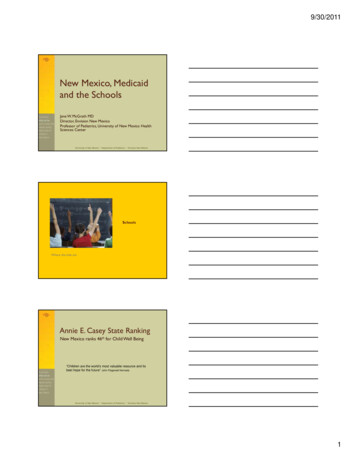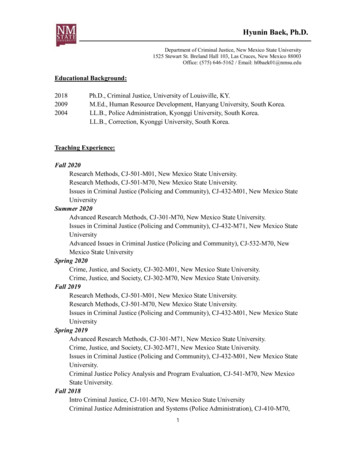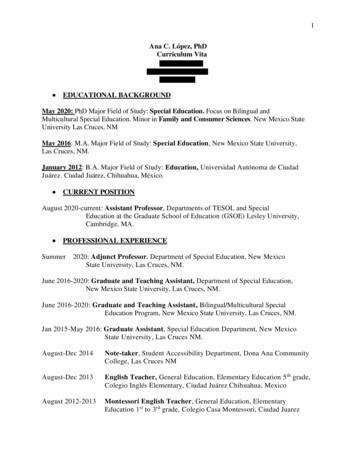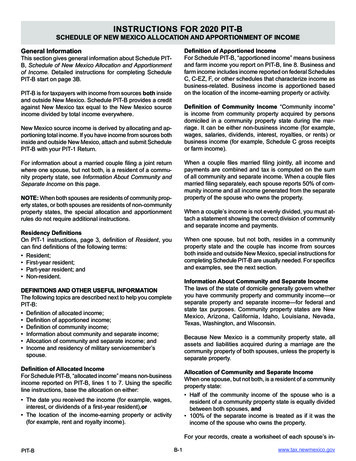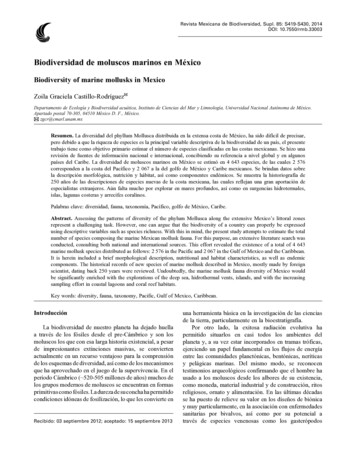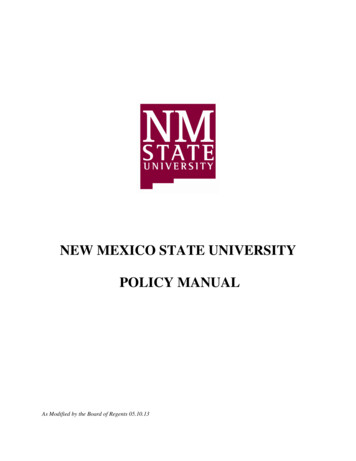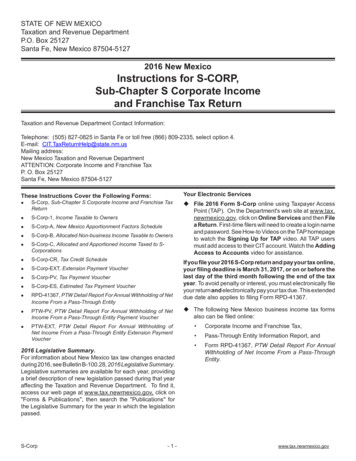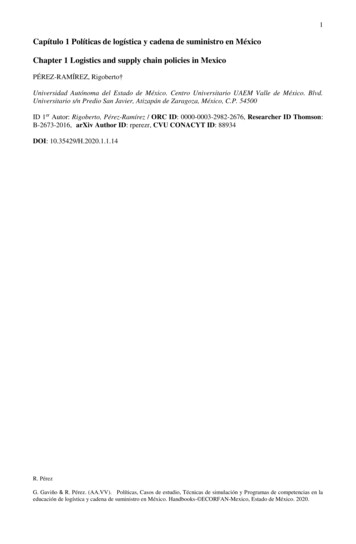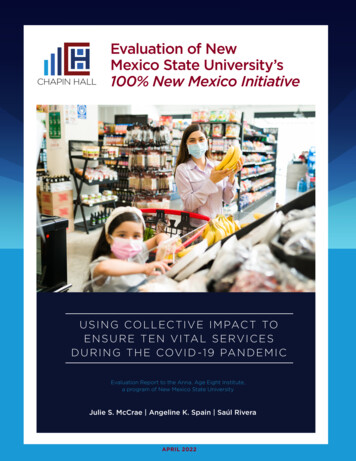
Transcription
Evaluation of NewMexico State University’s100% New Mexico InitiativeU S I N G C O L L EC T I V E I M PAC T TOE N S U R E T E N V I TA L S E RV I C E SD U R I N G T H E C OV I D -1 9 PA N D E M I CEvaluation Report to the Anna, Age Eight Institute,a program of New Mexico State UniversityJulie S. McCrae Angeline K. Spain Saúl RiveraAPRIL 2022
Recommended CitationMcCrae, J. S., Spain, A. K., & Rivera, S. (2022). Evaluation of the New Mexico State University’s 100%New Mexico Initiative Using Collective Impact to Ensure Ten Vital Services during the COVID-19Pandemic. Chicago, IL: Chapin Hall at the University of Chicago.AcknowledgementsThis project was a collaboration between Chapin Hall and the Anna, Age Eight Institute at NewMexico State University. The Chapin Hall team would like to thank the leaders and action teams of100% New Mexico for sharing their experiences with us and for their commitment to addressingsocial adversity, building ten vital services and reducing adverse childhood experiences and trauma.We thank the Anna, Age Eight Institute for their partnership and evaluation support.DisclaimerThe points of view, analyses, interpretations, and opinions expressed here are solely those of theauthors and do not necessarily reflect the position of the Anna, Age Eight Institute or New MexicoState University.ContactJulie S. McCrae, Senior Researcher, Chapin Hall at the University of Chicagojmccrae@chapinhall.org; 720-442-1785Chapin Hall adheres to the values of science, meeting the highest standards of ethics, integrity, rigor, andobjectivity in its research, analyses, and reporting. Learn more about the principles that drive our work in ourStatement of Independence.Chapin Hall partners with policymakers, practitioners, and philanthropists at the forefront of research andpolicy development by applying a unique blend of scientific research, real-world experience, and policyexpertise to construct actionable information, practical tools, and, ultimately, positive change for children andfamilies.Established in 1985, Chapin Hall’s areas of research include child welfare systems, community capacity tosupport children and families, and youth homelessness. For more information about Chapin Hall, visitwww.chapinhall.org or @Chapin Hall. 2022 Chapin Hall at the University of Chicago1313 East 60th StreetChicago, IL 60637chapinhall.org
TABLE OF CONTENTSList of Figures . ivExecutive Summary.5Introduction . 5Background . 5Methods . 5Findings . 6Recommendations . 6Introduction .8Methods . 11Findings . 14Discussion. 27Recommendations . 29References . 30Appendix A. Background of 100% Community . 33Appendix B. Population Characteristics for Counties Participating in 100% New Mexico . 34Appendix C. Evaluation Protocols . 36Chapin Hall at the University of ChicagoMcCrae, Spain, & Rivera iii
LIST OF FIGURESFigure 1. Five surviving and five thriving services.9Figure 2. Sectors represented by survey respondents . 13Figure 3. Action teams represented by survey respondents . 14Figure 4. Current focus of 100% work . 15Figure 5. Multiple pathways toward developing 100% . 16Figure 6. Foundations for impact, as reported by survey respondents. 19Figure 7. Alignment between 10 vital services and largest crises experienced by families during theCOVID-19 pandemic . 20Figure 8. Components of collective impact. 22Figure 9. Importance of city and county government becoming funders of 100% initiatives in thefuture, as reported by survey respondents . 24Chapin Hall at the University of ChicagoMcCrae, Spain, & Rivera iv
EXECUTIVE SUMMARYINTRODUCTIONThe need to ensure that families and community residents have access to services for surviving andthriving has become ever more visible during the global COVID-19 pandemic and economic crisis.This study describes the results of a developmental evaluation study conducted by Chapin Hall ofeight New Mexico counties’ adaptation of the 100% New Mexico model to ensure 10 vital servicesduring the COVID-19 global pandemic.BACKGROUNDThe Anna, Age Eight Institute (Institute) at New Mexico State University was formed in 2018 toempower the local champions who build the vital services to ensure trauma-free and thrivingchildren, students and families. 1 The Institute’s founders are guided by research focused on the socialdeterminants of health and ensuring access to vital services to increase health, safety, schoolachievement, job readiness and resilience. 2 The Institute began as the result of the book written byfounders Dr. Katherine Ortega Courtney and Dominic Cappello, Anna, Age Eight: The Data DrivenPrevention of Childhood Trauma and Maltreatment. A second book, 100% Community: Ensuring 10vital services for surviving and thriving (Ortega Courtney, PhD & Cappello, 2019) provides theframework and tools to accomplish the goal of ensuring access to 10 vital services among all NewMexicans. Communities use a data-driven collective impact model and 10 local action teamscentered in service sectors for surviving and thriving. As of June 2021, 100% New Mexico was beingimplemented in eight counties.METHODSThis study used a developmental evaluation approach, with the goal of informing the Institute’sleadership for ongoing implementation of 100% New Mexico and understanding collective impact.Building on a pilot study conducted by Chapin Hall in 2019, we worked closely with the 100% NewMexico developers to prioritize three key domains for inquiry. These included investigating: (1)implementation progress in participating counties, (2) development of core components of collectiveimpact and the seven model steps in participating counties, and (3) 100% New Mexico adaptation inthe context of the COVID-19 pandemic and associated economic disruption.We conducted interviews (n 12) and focus groups (n 2, 9 participants) and administered a survey(n 45) for this study. We transcribed and thematically analyzed interviews and focus groups tosystematically identify implementation experiences from the lens of collective impact and the role ofthe 100% New Mexico framework and activities in how community responses launched in apin Hall at the University of ChicagoMcCrae, Spain, & Rivera 5
county in response to the COVID-19 pandemic. Survey results were analyzed using descriptive meansand proportions. We then validated themes and survey findings with the developers of 100% NewMexico, clarifying aspects of how individual counties had been supported in their implementation.FINDINGSBased on our analysis, we highlight four main findings.1. The 100% New Mexico model’s emphasis on surviving and thriving services resonatedstrongly with counties during the COVID-19 pandemic and economic crisis. Initiativemembers indicated that this framework supported their efforts to conceptualize andcoordinate community COVID-19 emergency response needs.2. 100% New Mexico’s community-led approach empowered implementing counties toleverage existing strengths. Champions and other initiative members reported that theflexibility supported by the model was critical to their ability to engage key communityleaders and sectors effectively and develop their initiatives in ways that incorporated localcontext and assets.3. Implementing 100% New Mexico initiatives bolstered counties’ cross-sector communicationand use of continuous improvement to strengthen their implementation activities. Theseareas of growth align with core components of collective impact and contributed to greatercoordination across a range of mobilization efforts, including both those led by 100%members and by existing local coalitions.4. Capacity gaps emerged as counties’ 100% New Mexico volunteer-led initiatives worked toshift from needs identification to action. Reliance on volunteer capacity, particularly in thecontext of the COVID-19 pandemic, resulted in uneven progress in developing a robustbackbone infrastructure and shared approach to measurement.RECOMMENDATIONSWe offer the five recommendations below for consideration.1. Refine how the model conceptualizes leadership roles for local 100% New Mexicomembers. These roles include champions, core team members, action team co-chairs, actionteam members, and general members of the coalition. Consider articulating milestones forvolunteer-led efforts and readiness for part- or full-time staff positions to managecommunication and the implementation of solutions.2. Foster connections across counties implementing the 100% New Mexico initiativefocused on the 10 specific vital services sectors. Pilot cross-community workshops andvirtual sessions to exchange strategies and identify promising strategies to address barriersto access to high quality, user-friendly services.3. Add technical assistance opportunities that address adaptive leadership and the use ofsurvey and other data to identify and develop data-driven solutions to communityChapin Hall at the University of ChicagoMcCrae, Spain, & Rivera 6
needs. Prioritize opportunities that support 100% New Mexico leaders to transition fromneeds identification to action.4. Partner with key decision makers and lawmakers to bolster the resources that countiesimplementing 100% New Mexico can leverage to sustain coordination within and acrossthe service sectors to implement solutions. Critical stakeholders include local and statedecision makers and lawmakers, leadership in public health, behavioral health care, publiceducation, higher education, early childhood development, workforce development, healthequity advocates, transportation, housing and food security, and county health councils.5. Further clarify how the model conceptualizes the 7-step process. In particular, determinewhere mural projects, book clubs, and updating the family service directory, developing afamily service center one-stop service hubs, transforming schools into community serviceswith health centers as service hubs, and ending the digital divide (to increase access to webbased services) can serve as meaningful tools for coalition members to sustain momentumand expand community interest in the cross-sector approach. Guidance around whatconstitutes core components of the model and what aspects are flexible will continue toparticularly as counties leverage the model in an environment made more challenging by theconsequences of the pandemic and disruptions in family services, health care, education, andlocal economies.Chapin Hall at the University of ChicagoMcCrae, Spain, & Rivera 7
INTRODUCTIONCOVID-19 was declared a global pandemic by the World Health Organization in March 2020 3. Due torates of virus transmission, hospitalizations, and mortality related to the virus, the United States,along with many other countries, instituted lockdowns, quarantines, travel restrictions and othermitigation measures. Businesses, schools, and family-serving agencies involving personal contactwere forced to shut down or drastically alter their practices, which helped reduce physical healthimpact (Borjas, 2020), but caused multiple ripple effects. Many individuals lost their jobs andincomes, and unemployment disproportionally affected people of color (Centers for Disease Control,2021). Students lost years of normal educational supports in school settings. Families have beenimpacted particularly hard, with increased rates of difficulty paying for housing, food, and medicalcosts, and unavailability of childcare (Karpman et al., 2020).As of June 2021, New Mexico had reported 205,542 total COVID-19 cases. New Mexico’s leadershiphad acted swiftly to declare a public health emergency in April 2020 (Executive Order 2020-04)followed by ongoing amendments to COVID-19 safety and mitigation protocols across the state.However, people of color have still fared worse in New Mexico compared to other New Mexicans,with the highest rates of infection, hospitalization and mortality among the state’s Hispanic andLatino, American Indian, and Hawaii, Pacific Islander, and Alaska Native rd). Many in the state have experienced anxiety anddifficulty with economic and social needs, with 88% expressing overwhelming concern about beingable to pay rent or their mortgage and 89% indicating that they were uncomfortable returning to theworkforce and education settings (New Mexico Department of Workforce Solutions, 2020). Manywere unable to return to work due to lack of access to health care and childcare (New MexicoDepartment of Workforce Solutions, 2020). The pandemic has heightened inequities in our systemsof locally-based care and family empowerment, including medical care, behavioral health care, foodsecurity programs, housing security programs, public transportation, parent supports (includingnavigation to vital services), early childhood learning programs, fully-resourced community schoolswith health center, youth mentor programs and job training.A significant effort by the initiative to bolster support to New Mexicans to reduce health, education,and service disparities and prevent social adversity was well underway at the onset of the pandemic.The Anna, Age Eight Institute (Institute) at New Mexico State University was formed in 2018 toempower the local champions who build the vital services to ensure trauma-free and thrivingchildren, students and families. 4 The Institute’s founders are guided by research focused on the socialdeterminants of health, focused on ensuring vital services to increase health, safety, schoolachievement, job readiness and resilience.2 The Institute began as the result of the book written by34WHO Director-General’s opening remarks at the media briefing on COVID19 -March 2020https://annaageeight.nmsu.eduChapin Hall at the University of ChicagoMcCrae, Spain, & Rivera 8
founders Dr. Katherine Ortega Courtney and Dominic Cappello, Anna, Age Eight: The Data DrivenPrevention of Childhood Trauma and Maltreatment. In 2019, a second book, 100% Community:Ensuring 10 vital services for surviving and thriving (Ortega Courtney, PhD & Cappello, 2019) providesthe framework and tools for implementing 100% Community to accomplish the goal of ensuringaccess to 10 vital services among all New Mexicans.The focus on strengthening 10 vital services for surviving and thriving is the cornerstone of the 100%Community model, as these are viewed as critical to developing community systems of care thatsupport residents and families to survive and thrive. The five surviving services are food, housing,medical and dental care, behavioral health care and transportation. The five thriving services areparent supports, early childhood learning, community schools, youth mentors, and job training.Figure 1 outlines these 10 service sectors that counties center on strengthening to produce impactcollectively 5.Figure 1. Five surviving and five thriving servicesCore Model ComponentsThe 100% New Mexico initiative is guided by research focused on the social determinants of healthand health equity. The approach follows the social-ecological model used primarily in public health,with activities focused on following levels: individual, family, community and system (policy) (OrtegaCourtney & Cappello, 2021). As a guide for organizing initiative work on the county level, the sectors-research.htmlChapin Hall at the University of ChicagoMcCrae, Spain, & Rivera 9
mobilizing work is based on collective impact, which is a systems approach to social impact thatmoves beyond the isolated effect that individual organizations or agencies can make on an issue tothe impact of all agencies collectively (Kania and Kramer, 2011). Different agencies across county andcity government, non-profit organizations, philanthropic entities, and private sector partners alignpriorities and collaborate to address complex problems to achieve measurable and meaningfulresults in the form of ensuring all county residents have access to the ten vital services for survivingand thriving.Implementing the model involves Continuous Quality Improvement (CQI) and seven steps thatcounties or communities complete through 10 local action teams (1 for each service sector). Thesteps are: (1) survey county residents about the need for, and access to, the 10 vital services; (2)review survey results to identify service gaps; (3) assess local organizations and their capacity toprovide the 10 surviving and thriving services; (4) provide an updated and locally curated web-basedand print directory of local services; (5) identify and implement innovative and evidence-informedsolutions (including technological advances) to end barriers; (6) get buy-in from local government;and (7) evaluate effectiveness of the innovations. The Institute supports communities throughmultiple activities including website formation for each county, analyzing survey data and producingreports of survey results, providing continuous shared learning opportunities, and engaging witheach community directly to provide individualized support and capacity-building. In 2021, ten ofNew Mexico’s 33 counties are implementing the 100% New Mexico initiative (hereafter called 100%New Mexico).(Note: Most counties engaged with the initiative after implementing a local book club focused onreading Anna, Age Eight: The data-driven prevention of childhood trauma and maltreatment and100% Community: Ensuring 10 vital services for surviving and thriving, with book club memberscoming from local government and family-serving agencies.)Purpose of the EvaluationChapin Hall evaluated implementation of 100% New Mexico in eight counties in January-June 2021.The counties are located in different geographic locations of the state and vary in the assets andresources that they have brought to their adaptations of the 100% model, which provides a richopportunity to identify critical aspects of the local context that have shaped implementation in thecounties. The purpose of the evaluation was to document drivers of the initiative’s initial progress,examine how the model was applied to support community responses to COVID-19, and assessspecific progress in the seven implementation steps and components of collective impact. We alsoinvestigated community leaders’ satisfaction with the technical assistance provided by the Instituteand opportunities for enhancing support according to initiative members.Chapin Hall at the University of ChicagoMcCrae, Spain, & Rivera 10
Participating Counties100% New Mexico was launched in the eight counties beginning in 2019. Counties range in size froma population of less than 4,000 (Catron County) to over 200,000 residents in 2019 (Doña AnaCounty). The average median annual income among the participating counties is lower than themedian annual income among all New Mexico counties ( 36,898 compared with 46,844). Togetherthe participating counties represent 23% of New Mexico’s total residents and 24% of New Mexico’schildren under age 19. County populations are 50%-77% Hispanic/Latinx in six of the eightparticipating counties, with two counties (Catron and Otero) having a smaller Hispanic/Latinxpopulation (19% and 38%, respectively) compared with the state as a whole (49%) 6. All participatingcounties have higher high school graduation rates compared with the rest of the state. Most of thecounties had higher rates of poverty for the total population and the population of children (0-17).Several counties have significantly fewer numbers of health care providers compared to the needs ofthe population. Characteristics of the eight counties are included in Appendix B.METHODSThis study used a developmental evaluation approach, with the goal of informing the Institute’sleadership for ongoing implementation of 100% New Mexico. In general, developmental evaluationsare intended to support program decision makers’ strategic learning about program developmentand guide adaptation to local community contexts (Patton, 2010). This type of evaluation isparticularly well suited to the early stages of collective impact change processes, whereimplementers are still defining how they will measure progress and evaluate effectiveness andimpact (Preskill, Parkhurst, & Splansky-Juster, n.d.).Building on a pilot study conducted by Chapin Hall in 2019, we worked closely with the 100% NewMexico developers to prioritize three key domains for inquiry. This included investigating: (1)implementation progress in participating counties, (2) development of core components of collectiveimpact and the seven model steps in participating counties, and (3) 100% New Mexico adaptation inthe context of the COVID-19 pandemic and associated economic disruption. We investigatedimplementation progress, collective impact and the seven steps in all participating counties and useda case study design in one community (San Miguel County) to understand the 100% New Mexicoframework and activities as a strategy for community crisis response.All procedures for this evaluation were approved by the Crown Family School of Social Work, Policy,and Practice and Chapin Hall at the University of Chicago Institutional Review Board.6New Mexico's Indicator-Based Information System (NM-IBIS)Chapin Hall at the University of ChicagoMcCrae, Spain, & Rivera 11
Data SourcesWe collected three types of data for this study: interviews, surveys, and focus groups.Interviews. We conducted virtual interviews in June 2021 with 12 individuals. Ten of the interviewswere with individuals in Core Action Team roles in each county. Two of the interviews were withindividuals chairing Action Teams in San Miguel County specifically. Overall, all eight participatingcommunities were represented in the interviews. The interviews addressed the following topics:involvement with 100% and initial implementation experiences; county crisis responses to theCOVID-19 pandemic; progress toward collective impact; and technical assistance provided by theInstitute. The interviews averaged 45 minutes in length.Survey. We conducted an online survey in seven 7 counties in June 2021. We built the survey inREDCap software; Institute leadership asked the leaders in each county to disseminate the survey linkto community members participating in the initiative. In total, 45 individuals responded to the survey,representing all seven counties. The survey addressed the following topics: involvement andimplementation experiences; current foundation for impact as a county and within action teams;goals for the initiative in the county; priorities for future technical assistance, and respondentdemographic characteristics.Focus groups. For the case study specifically, we conducted virtual focus groups with multiplemembers of two Action Teams (n 2 and n 7) in June 2021. The focus groups averaged 60minutes in length. The focus groups addressed: involvement with 100% and initial implementationexperiences of the Action Team and overall; county crisis responses to the COVID-19 pandemic;progress toward collective impact; and technical assistance provided by the Institute.All data collection instruments are included in Appendix C.Data AnalysisWe transcribed and thematically analyzed interviews and focus groups to systematically identifyimplementation experiences and specific examples of successes and challenges related to each ofthe five core conditions for collective impact. We reviewed these data to identify contextual factorsspecific to the counties, as well as when the counties began implementation. We also examined therole of the 100% framework and activities in how community responses launched in each county inresponse to the COVID-19 pandemic. The survey was analyzed using descriptive means andproportions.San Miguel was conducting their needs assessment survey at the time of data collection, so was notincluded in the evaluation survey.7Chapin Hall at the University of ChicagoMcCrae, Spain, & Rivera 12
We then validated themes and survey findings with the developers of 100% Community, clarifyingaspects of how individual counties had been supported in their implementation. We discussedlessons learned by the developers from the implementation across the state to deepen ourunderstanding of facilitators and barriers to progress that may be unique to particular counties, thecommitments and interest of community leaders in preventing childhood trauma, and opportunitiesto enhance the model and support 100% initiative members to design projects in response toidentified community needs.Survey respondentsThe 45 survey respondents represent seven 8 of the eight participating counties. The counties withthe largest proportion of respondents were from Valencia (33%), followed by Otero (31%), Doña Ana(18%), and Taos (11%), Rio Arriba (4%), and Catron (2%). As shown in Figure 2, most participantswere from non-profit (23%) or state government (21%) sectors. The remaining were currently retired(17%), other (15%), city government (9%), higher education (9%), private sector (4%), and countygovernment (2%).Figure 2. Sectors represented by survey respondentsPrivate sector4%Higher education9%County government2%Non-profit23%City government9%Other15%State government21%Retired17%As noted above, we did not administer the survey in San Miguel due to their simultaneousimplementation of their county needs assessment.8Chapin Hall at the University of ChicagoMcCrae, Spain, & Rivera 13
Figure 3 reports the Action Teams represented by survey respondents. Among participants whoindicated the action team they are on, 22% were Community schools, 19% were Behavioral health,19% were Early childhood education, 9% were Housing, 9% were Mentoring programs, 9% wereMedical, 6% were Parental supports, 3% were Food, and 3% were Transportation.Figure 3. Action teams represented by survey respondentsTransportation 3%FINDINGSWe present key findings organized by research question.What were community experiences developing the 100% New Mexico initiative?Cross-sector framework and community-led development as key assetsThe eight counties that participated in this study had prior experience with different collaborativesand efforts to improve services for community residents and families. The local champions of 100%New Mexico differentiated this initiative from these other experiences in three primary ways. First,they characterized the model’s focus on 10 vital services as resonating with community experiences.A local champion explained, “People who need food, they often need other things: like housing, likebehavioral health, like childcare. It's
Evaluation of the New Mexico State University's 100% New Mexico Initiative Using Collective Impact to Ensure Ten Vital Services during the COVID -19 Pandemic. Chicago, IL: Chapin Hall at the University of Chicago. Acknowledgements This project was a collaboration between Chapin Hall and the Anna, Age Eight Institute at New Mexico State .
